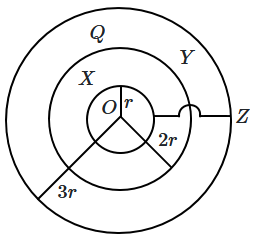A metal rod at a temperature of \(145^\circ\mathrm{C}\), radiates energy at a rate of \(17~\mathrm{W}\). If its temperature is increased to \(273^\circ\mathrm{C}\), then it will radiate at the rate of:
1. \(
49.6 \mathrm{~W}
\)
2. \( 17.5 \mathrm{~W}
\)
3. \( 50.3 \mathrm{~W}
\)
4. \(67.5 \mathrm{~W}\)
A metal rod at a temperature of \(145^\circ\mathrm{C}\), radiates energy at a rate of \(17~\mathrm{W}\). If its temperature is increased to \(273^\circ\mathrm{C}\), then it will radiate at the rate of:
1. \(
49.6 \mathrm{~W}
\)
2. \( 17.5 \mathrm{~W}
\)
3. \( 50.3 \mathrm{~W}
\)
4. \(67.5 \mathrm{~W}\)
2. 1 : 2
3. 3 : 1
4. 1 : 3
A square wire of side \(2.0~\mathrm{cm}\) is placed \(20~\mathrm{cm}\) in front of a concave mirror of focal length \(10~\mathrm{cm}\) with its centre on the axis of the mirror and its plane normal to the axis. The area enclosed by the image of wire is:
1. \(
7.5 \mathrm{~cm}^2
\)
2. \( 6 \mathrm{~cm}^2
\)
3. \(2 \mathrm{~cm}^2 \)
4. \(
4 \mathrm{~cm}^2\)
A lead bullet penetrates into a solid and melts. Assuming that \(50\%\) of its kinetic energy was used to heat it, the initial speed of the bullet is: (the initial temperature of the bullet is \(25^\circ\mathrm{C}
\) and its melting point is \(300^\circ\mathrm{C}
\)). Latent heat of fusion of lead \(=2.5\times10^4~\mathrm{J/Kg}\) and specific heat capacity of lead \(=125~\mathrm{J/Kg-K}\).
1. \(
100 \mathrm{~m} / \mathrm{s}
\)
2. \( 490 \mathrm{~m} / \mathrm{s}
\)
3. \( 520 \mathrm{~m} / \mathrm{s}
\)
4. \( 360 \mathrm{~m} / \mathrm{s}\)

1. \( 1 / 2 \)
2. \( 1 / 3 \)
3. \( 4 / 3 \)
4. \( 2 / 3\)

| (i) | Ratio of work functions \(\phi_1,\phi_2\) and \(\phi_3\) = 1: 2: 4 |
| (ii) | Ratio of work functions \(\phi_1,\phi_2\) and \(\phi_3\) = 4: 2:1 |
| (iii) | \(\tan\theta\propto\frac{hc}{e},\) Where h = plank’s constant, c = speed of light |
| (iv) | The violet-colour light can eject photoelectrons from metals 2 and 3 |
2. (i), (iv)
3. (ii), (iii)
4. (i), (ii) and (iv)
The concentric, conducting spherical shells \(X,~ Y\) and \(Z\) with radii \(r, ~2r\) and \(3r\) respectively. \(X\) and \(Z\) are connected by a conducting wire and \(Y\) is uniformly charged to charge \(Q\) as shown in the figure. Charges on shells \(X\) and \(Z\) will be:
1. \(qx=\frac{Q}{4},qz=\frac{-Q}{6}\)
2. \(qx=\frac{-Q}{4},qz=\frac{Q}{4}\)
3. \(qx=\frac{Q}{4},qz=\frac{-Q}{4}\)
4. \(qx=\frac{-Q}{6},qz=\frac{Q}{4}\)
A particle slides down on a smooth incline of inclination , fixed in an elevator going up with an acceleration of 2 m/s2. The box of incline has a length of 4 m. The time taken by the particle to reach the bottom will be:
1. \(\frac89\sqrt3s\)
2. \(\frac98\sqrt3s\)
3. \(\frac43\sqrt{\frac{\sqrt3}{2}}s\)
4. \(\frac34\sqrt{\frac{\sqrt3}{2}}s\)
A stone projected with a velocity \(u\) at an angle \(\Big(\frac{\pi}{2}-\theta\Big)\) with the horizontal reaches maximum height \(H_1\) When it is projected with velocity \(u\) at an angle with the horizontal, it reaches maximum height Hz. The relation between the horizontal range \(R\) of the projectile, \(H_1\) and \(H_2\) is:
1. \(R=4\sqrt{H_1H_2}\)
2. \(R=4({H_1-H_2})\)
3. \(R=4({H_1+H_2})\)
4. \(R=\frac{H^2_1}{H_2^2}\)




